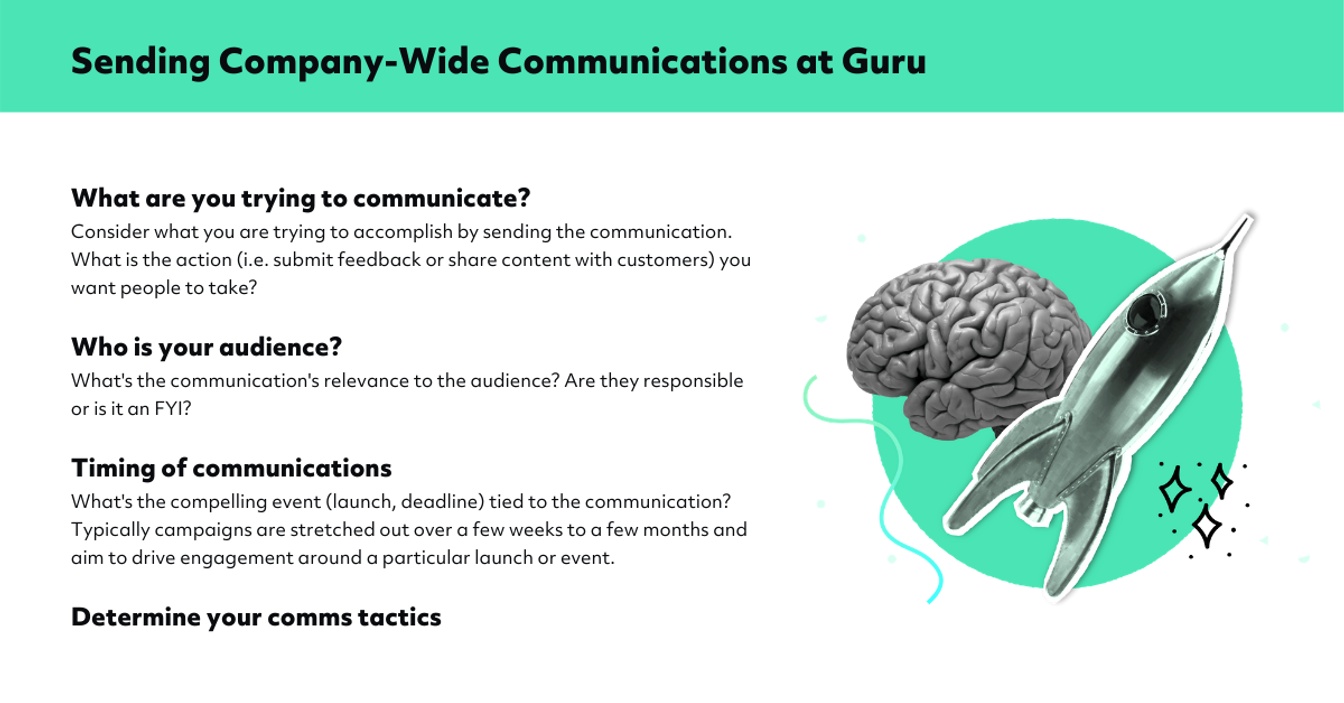Guru's Golden Rule of Internal Communications
ハイブリッド職場で生き残り、成功するためには、適切なコミュニケーションが重要です。 だからこそ、私たちはGuruにおけるすべての内部コミュニケーションのための黄金のルールに従います。
Guruでは、私たちは職場が永遠に変わると信じています。 パンデミックは私たち全員を、100%のリモートでの仕事を直ちに行うという選択肢のない実験に強制しました。
これが皆に異なる形で影響を与えましたが、はっきりしたことの一つは、チームが対面からバーチャルに100%のインタラクションを移行する際の課題です。 私たちのコミュニケーションの方法、持ち寄る会議のタイプ、効果的に協力するために必要なツールが明るく照らされ、うまく機能するもの、全く機能しないもの、実際にはより良く機能できるものが浮き彫りになりました。
オフィスが再開されると、物事は単に「前の通りに戻る」ことはほぼないでしょう。 多くのチームは、リモートとオフィスでの労働日を混合した形での「ハイブリッド」職場で運営するでしょう。 これはとても前向きな変化だと思います。なぜなら、私たちは、対面で最も成果を上げられる活動と、家や中断のないスペースで最も効果的に進められる活動に基づいて仕事を最適化することになるからです。 言うまでもなく、柔軟な働き方によって可能になる私たちの私生活への利益があります。
この変化の中心には、職場のコミュニケーションが同期から非同期にシフトするという考えがあります。 チームがもはや対面で集まらず、同じ建物にさえいないという前提に基づいて、チームがコミュニケーションを取る方法の多くが設計されることになります。 チームのインタラクションをライブ会議にデフォルト設定するのではなく、アイデア、知識、ステータス更新、FAQ、ポリシー、決定を文書化し、チームと共有して、読む、コメントする、行動するといったことができるようになります。
「黄金のルール」を定義する
この新しいダイナミクスでは、チームの全員が読み書きの両方で重要な役割を果たします。 「リモートネイティブ」として成長したいくつかのチームの例があり、彼らは書かれた文化について語り、これが運営の中核であることを説明しています。
Guruの核心的な価値の一つは、知識を求め、共有することです。
私たちはGuruでオープンで透明性のあることを大切にし、これらの行動が会社の運営の一部であることを確保する義務があります。 この目標を達成するために、私たちは最近、内部コミュニケーションの黄金ルールを発表しました:
私たちは知識を求め、共有します。 これを機能させるためには、Guruで働く皆さんとの「契約」が必要です。 これは、私たち全員が2つのことを約束することを意味します…。
(1)あなたは、他の人があなたが共有するものを消化しようとすることを知って、非同期に知識を共有します。 あなたは、共有する相手を認識し、彼らが理解することが重要であるため、彼らのために最適化します。
(2)あなたは、他の人が準備するのに時間をかけた知識を消化しようとします。 もし共有されるものが不明確または関連性がない場合、あなたは今後の共有を改善するためにそのフィードバックを共有する価値を認識します。
私たちは、このルールの2つの要素が重要であると信じています。 それぞれを分解していきましょう。まずはパート1から:
あなたは非同期に知識を共有します…
これは通常、書かれたまたは録音された知識を指します。 それには、単に読むこと、コメント、投票、アイデアの要求などが含まれ、いつこれを完成させたいかの期日も含まれます。 これがステータスアップデート、決定が必要なこと、または新商品発売をサポートする製品知識である場合もあります。
…みんながあなたの共有するものを消化しようとすることを知っている。
書くこと、録音することには時間がかかります。 私たちは、仲間たちが私たちが準備したことを読むことを楽しみにしていると想定し、これが私たちのモチベーションとなってこの仕事に時間を費やします。 (このことについては、私たちのルールの第2部でさらに説明します。)
あなたは共有する相手を認識し、彼らに最適化します…
私たちは、チームの一部にしか関連していないかもしれない一斉通知を避けるように努め、高い信号対雑音比を保ちます。
…彼らが理解することが重要だからです。
情報を得たチームは、インスパイアされ、関与し、行っている仕事に興奮しやすいです。 私たちは皆、これに貢献する役割を果たします!
これは最初の「半分」であり、他の人をインフォームするために作業する時間を取ることを約束することです。 では、後半を検討してみましょう:
あなたは他の人が共有するために準備した知識を消化しようとします。
上記で述べたように、ここでの要求は「知識共有の両側」が機能するためには必要であると認識することです。 誰かがライブ会議を設定し、もう一人が来ない場合の気持ちは、皆さんも知っていることでしょう。 これは同じように感じるはずです。
もし共有されるものが不明確または関連性がない場合、あなたは今後の共有を改善するためにそのフィードバックを共有する価値を認識します。
このループの最後の部分は…誰もが完璧に書くことはできません! どうやってライターが彼らのコミュニケーションを改善できるのかという親切で率直なフィードバックを提供することは、今後のコミュニケーションの流れを強化します。 それはまた、ライターに対して彼らが書いたものに対して関心を持っていることを示します。
誰がこれを全部やる時間があるのでしょうか? 私の一日はすでに会議でいっぱいです!
あなたの考えがわかります…ですが、まさにここから魔法が始まります! チームが黄金のルールを守るための最も価値のある結果の一つは、スピードです。 ライブ会議は調整を必要とします。 私たちはカレンダーを見て、会話に参加する必要がある全員に都合の良い時間を見つける必要があります。 会議が大きければ大きいほど、スケジュールがさらに先に延びることになり、空いている時間帯が減少します。 このトピックは重要な決定で、作成する必要がありますが、皆がこれをうまく調整できるように、今日から1週間後に会議をスケジュールしなければなりません。
この状況では、私たちは最初の会話を持つ前にすでに1週間を失っています! 今や異なるタイムゾーンや作業スケジュールを加えると、突然、一般的なオープン時間帯はさらに狭くなります。
では、黄金のルールに従うチームのためにどのように機能するかを見てみましょう。
ある人がチームとつながりたいトピックを考えていると想像してください。 彼らはそのトピックを書き留め、チームメイトにスラックして、次の2日間でフィードバックを求めます。 彼らはチームメイトからコメントを見ることができ、それに自分の時間で対処します。 より多くのチームメイトがコメントし、返信が増え、数日後には、この書かれたトピックがすでに多くのフィードバック、懸念、アイデアをキャッチし、文書化されています。
同期的なアプローチでは、最初の会議はまだ行われていません。 しかし、非同期アプローチでは、数日後にトピックが取り上げられ、チームは次に進んでいます。 これが私たちのチーム全体で繰り返し起きることを想像してください。 コラボレーションは、ライブ会議:進歩の殺人者から、黄金のルール:チームのスーパーパワーと実行における利点にシフトしています。
私たちが職場で黄金のルールに従う方法
黄金のルールは私たちにとって新しいもので、今年導入しました。 ここにGuruで私たちが黄金のルールに従っているいくつかの初期の方法があります。
「目的のあるコミュニケーション」を確実にすること
これは、私たちがすべての従業員に提供するガイドです。 これは、私が先に述べた高い信号対雑音比に関するものです。
私たちは意思決定方法論を活用しています
私たちは、できる限り非同期で意思決定を進めるために意思決定文書の使用を奨励しています。これは(1)完全に非同期で決定を行うことを可能にするか、(2)ライブ会議が行われるときには、すべての人が非常に進んでおり、通常会議の目標は決定を最終化することです。 私たちはまた、DRIの概念を使用して、どのように決定が下され、誰がそれを行うかを明確にします。
私たちは、チームが話し合いたいトピックに関する事前を奨励します。
会議の事前読みは、私たちにとって良い次のステップのように感じます。 それらは会議の前に全員を同じページにし、スライドを提示する代わりに積極的に話し合う時間を無駄にすることを防ぎます。 私たちにとっての次の質問は、どこでライブ会議を完全に回避できるかですか?
私たちはSlackのベストプラクティスを確立します。
私たちは、ほとんどの会話を公共のチャネルで行うことを奨励します。 私たちは公共のチャネルで@メンションを奨励し、仲間に行動を促し、すべてのチャッターを管理します。 雑音の中での信号を助ける別の例です。 私たちはまた、緊急性指標も使用しています。 たとえば、読んでコメントする文書を提供する場合、1日、3日、5日の短縮形を使用して、読者に応答する時期を理解してもらいます。
私たちはお知らせを送信するためにGuruを使用します。
お知らせは特定の人々のグループに送信され、何かを読むための明確な行動が提示されます。 アラートはキューに入れられ、私たちのウェブアプリ、拡張機能、Slack、Teamsなどから簡単にアクセスできます。 私たちのお知らせの大部分はこのように配布されます。 これは重要な情報を伝えるための最高の信号対雑音の手段であることが最も効果的な例です。
私たちは、最も重要なプロジェクトの定期的なレビューを行います。
毎週木曜日に、私たちのプロジェクトDRIはAsanaでプロジェクトの更新を提供します。 毎週金曜日に、リーダーシップがAsanaを通じてレビューし、フィードバックを提供します。 これにより、私たちの最も重要な会社のイニシアチブ全体で迅速でオープンな非同期コミュニケーションが可能になります。
私たちは読書と執筆のカレンダーブロックを設けます。
私たちがこれを行う方法の一つは、水曜日に内部会議を行わないということです。 読書と執筆の時間を作ることは重要です。 私たちのほとんどは、ライブ会議をスケジュールして特定のトピックをカバーする方法を習慣的に考えています。 それはカレンダーに特定の時間が入っているので、その会話、つまり「対面の知識交換」がおそらく行われるでしょう。
しかし、黄金のルールの世界では、異なった方法で機能します。
私たちの時間の多くはこれらのライブ会議から移行し、読書と執筆の時間に特化します。 しかし、この時間はまだカレンダーに反映される必要があります。 私たちは、読書と執筆のために特に時間を確保する必要があります。 これは非常に効率的な時間であり、1時間の読み書きの時間がしばしば10時間のライブ会議の時間を節約します。
これがあなたに役立つガイドであり、これらの学びをチームに持ち帰ってもらえることを願っています! 私たちがここで学び続ける限り、確実に共有し続けます。 私が言ったように、多くの点で職場は最良の日々がこれからあると考えており、企業がこのような技術を認識すれば、会社の業績向上と従業員の満足度向上という両方の結果が得られます。
Guruでは、私たちは職場が永遠に変わると信じています。 パンデミックは私たち全員を、100%のリモートでの仕事を直ちに行うという選択肢のない実験に強制しました。
これが皆に異なる形で影響を与えましたが、はっきりしたことの一つは、チームが対面からバーチャルに100%のインタラクションを移行する際の課題です。 私たちのコミュニケーションの方法、持ち寄る会議のタイプ、効果的に協力するために必要なツールが明るく照らされ、うまく機能するもの、全く機能しないもの、実際にはより良く機能できるものが浮き彫りになりました。
オフィスが再開されると、物事は単に「前の通りに戻る」ことはほぼないでしょう。 多くのチームは、リモートとオフィスでの労働日を混合した形での「ハイブリッド」職場で運営するでしょう。 これはとても前向きな変化だと思います。なぜなら、私たちは、対面で最も成果を上げられる活動と、家や中断のないスペースで最も効果的に進められる活動に基づいて仕事を最適化することになるからです。 言うまでもなく、柔軟な働き方によって可能になる私たちの私生活への利益があります。
この変化の中心には、職場のコミュニケーションが同期から非同期にシフトするという考えがあります。 チームがもはや対面で集まらず、同じ建物にさえいないという前提に基づいて、チームがコミュニケーションを取る方法の多くが設計されることになります。 チームのインタラクションをライブ会議にデフォルト設定するのではなく、アイデア、知識、ステータス更新、FAQ、ポリシー、決定を文書化し、チームと共有して、読む、コメントする、行動するといったことができるようになります。
「黄金のルール」を定義する
この新しいダイナミクスでは、チームの全員が読み書きの両方で重要な役割を果たします。 「リモートネイティブ」として成長したいくつかのチームの例があり、彼らは書かれた文化について語り、これが運営の中核であることを説明しています。
Guruの核心的な価値の一つは、知識を求め、共有することです。
私たちはGuruでオープンで透明性のあることを大切にし、これらの行動が会社の運営の一部であることを確保する義務があります。 この目標を達成するために、私たちは最近、内部コミュニケーションの黄金ルールを発表しました:
私たちは知識を求め、共有します。 これを機能させるためには、Guruで働く皆さんとの「契約」が必要です。 これは、私たち全員が2つのことを約束することを意味します…。
(1)あなたは、他の人があなたが共有するものを消化しようとすることを知って、非同期に知識を共有します。 あなたは、共有する相手を認識し、彼らが理解することが重要であるため、彼らのために最適化します。
(2)あなたは、他の人が準備するのに時間をかけた知識を消化しようとします。 もし共有されるものが不明確または関連性がない場合、あなたは今後の共有を改善するためにそのフィードバックを共有する価値を認識します。
私たちは、このルールの2つの要素が重要であると信じています。 それぞれを分解していきましょう。まずはパート1から:
あなたは非同期に知識を共有します…
これは通常、書かれたまたは録音された知識を指します。 それには、単に読むこと、コメント、投票、アイデアの要求などが含まれ、いつこれを完成させたいかの期日も含まれます。 これがステータスアップデート、決定が必要なこと、または新商品発売をサポートする製品知識である場合もあります。
…みんながあなたの共有するものを消化しようとすることを知っている。
書くこと、録音することには時間がかかります。 私たちは、仲間たちが私たちが準備したことを読むことを楽しみにしていると想定し、これが私たちのモチベーションとなってこの仕事に時間を費やします。 (このことについては、私たちのルールの第2部でさらに説明します。)
あなたは共有する相手を認識し、彼らに最適化します…
私たちは、チームの一部にしか関連していないかもしれない一斉通知を避けるように努め、高い信号対雑音比を保ちます。
…彼らが理解することが重要だからです。
情報を得たチームは、インスパイアされ、関与し、行っている仕事に興奮しやすいです。 私たちは皆、これに貢献する役割を果たします!
これは最初の「半分」であり、他の人をインフォームするために作業する時間を取ることを約束することです。 では、後半を検討してみましょう:
あなたは他の人が共有するために準備した知識を消化しようとします。
上記で述べたように、ここでの要求は「知識共有の両側」が機能するためには必要であると認識することです。 誰かがライブ会議を設定し、もう一人が来ない場合の気持ちは、皆さんも知っていることでしょう。 これは同じように感じるはずです。
もし共有されるものが不明確または関連性がない場合、あなたは今後の共有を改善するためにそのフィードバックを共有する価値を認識します。
このループの最後の部分は…誰もが完璧に書くことはできません! どうやってライターが彼らのコミュニケーションを改善できるのかという親切で率直なフィードバックを提供することは、今後のコミュニケーションの流れを強化します。 それはまた、ライターに対して彼らが書いたものに対して関心を持っていることを示します。
誰がこれを全部やる時間があるのでしょうか? 私の一日はすでに会議でいっぱいです!
あなたの考えがわかります…ですが、まさにここから魔法が始まります! チームが黄金のルールを守るための最も価値のある結果の一つは、スピードです。 ライブ会議は調整を必要とします。 私たちはカレンダーを見て、会話に参加する必要がある全員に都合の良い時間を見つける必要があります。 会議が大きければ大きいほど、スケジュールがさらに先に延びることになり、空いている時間帯が減少します。 このトピックは重要な決定で、作成する必要がありますが、皆がこれをうまく調整できるように、今日から1週間後に会議をスケジュールしなければなりません。
この状況では、私たちは最初の会話を持つ前にすでに1週間を失っています! 今や異なるタイムゾーンや作業スケジュールを加えると、突然、一般的なオープン時間帯はさらに狭くなります。
では、黄金のルールに従うチームのためにどのように機能するかを見てみましょう。
ある人がチームとつながりたいトピックを考えていると想像してください。 彼らはそのトピックを書き留め、チームメイトにスラックして、次の2日間でフィードバックを求めます。 彼らはチームメイトからコメントを見ることができ、それに自分の時間で対処します。 より多くのチームメイトがコメントし、返信が増え、数日後には、この書かれたトピックがすでに多くのフィードバック、懸念、アイデアをキャッチし、文書化されています。
同期的なアプローチでは、最初の会議はまだ行われていません。 しかし、非同期アプローチでは、数日後にトピックが取り上げられ、チームは次に進んでいます。 これが私たちのチーム全体で繰り返し起きることを想像してください。 コラボレーションは、ライブ会議:進歩の殺人者から、黄金のルール:チームのスーパーパワーと実行における利点にシフトしています。
私たちが職場で黄金のルールに従う方法
黄金のルールは私たちにとって新しいもので、今年導入しました。 ここにGuruで私たちが黄金のルールに従っているいくつかの初期の方法があります。
「目的のあるコミュニケーション」を確実にすること
これは、私たちがすべての従業員に提供するガイドです。 これは、私が先に述べた高い信号対雑音比に関するものです。
私たちは意思決定方法論を活用しています
私たちは、できる限り非同期で意思決定を進めるために意思決定文書の使用を奨励しています。これは(1)完全に非同期で決定を行うことを可能にするか、(2)ライブ会議が行われるときには、すべての人が非常に進んでおり、通常会議の目標は決定を最終化することです。 私たちはまた、DRIの概念を使用して、どのように決定が下され、誰がそれを行うかを明確にします。
私たちは、チームが話し合いたいトピックに関する事前を奨励します。
会議の事前読みは、私たちにとって良い次のステップのように感じます。 それらは会議の前に全員を同じページにし、スライドを提示する代わりに積極的に話し合う時間を無駄にすることを防ぎます。 私たちにとっての次の質問は、どこでライブ会議を完全に回避できるかですか?
私たちはSlackのベストプラクティスを確立します。
私たちは、ほとんどの会話を公共のチャネルで行うことを奨励します。 私たちは公共のチャネルで@メンションを奨励し、仲間に行動を促し、すべてのチャッターを管理します。 雑音の中での信号を助ける別の例です。 私たちはまた、緊急性指標も使用しています。 たとえば、読んでコメントする文書を提供する場合、1日、3日、5日の短縮形を使用して、読者に応答する時期を理解してもらいます。
私たちはお知らせを送信するためにGuruを使用します。
お知らせは特定の人々のグループに送信され、何かを読むための明確な行動が提示されます。 アラートはキューに入れられ、私たちのウェブアプリ、拡張機能、Slack、Teamsなどから簡単にアクセスできます。 私たちのお知らせの大部分はこのように配布されます。 これは重要な情報を伝えるための最高の信号対雑音の手段であることが最も効果的な例です。
私たちは、最も重要なプロジェクトの定期的なレビューを行います。
毎週木曜日に、私たちのプロジェクトDRIはAsanaでプロジェクトの更新を提供します。 毎週金曜日に、リーダーシップがAsanaを通じてレビューし、フィードバックを提供します。 これにより、私たちの最も重要な会社のイニシアチブ全体で迅速でオープンな非同期コミュニケーションが可能になります。
私たちは読書と執筆のカレンダーブロックを設けます。
私たちがこれを行う方法の一つは、水曜日に内部会議を行わないということです。 読書と執筆の時間を作ることは重要です。 私たちのほとんどは、ライブ会議をスケジュールして特定のトピックをカバーする方法を習慣的に考えています。 それはカレンダーに特定の時間が入っているので、その会話、つまり「対面の知識交換」がおそらく行われるでしょう。
しかし、黄金のルールの世界では、異なった方法で機能します。
私たちの時間の多くはこれらのライブ会議から移行し、読書と執筆の時間に特化します。 しかし、この時間はまだカレンダーに反映される必要があります。 私たちは、読書と執筆のために特に時間を確保する必要があります。 これは非常に効率的な時間であり、1時間の読み書きの時間がしばしば10時間のライブ会議の時間を節約します。
これがあなたに役立つガイドであり、これらの学びをチームに持ち帰ってもらえることを願っています! 私たちがここで学び続ける限り、確実に共有し続けます。 私が言ったように、多くの点で職場は最良の日々がこれからあると考えており、企業がこのような技術を認識すれば、会社の業績向上と従業員の満足度向上という両方の結果が得られます。
Experience the power of the Guru platform firsthand – take our interactive product tour
見学する









